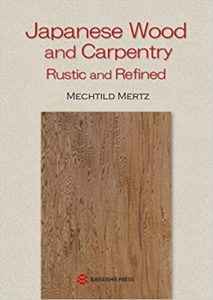
Japanese Wood and Carpentry, Rustic and Refined
By Mechtild Mertz
(reviewed by Judith Clancy)
Japan is a country whose primary building material is wood.
Walking the old streets of Kyoto or entering a temple reveals the legacy of Japan’s forests: the soothing calm symmetry of wood lattice-fronted homes; and temples with lustrous pillars treated with ancient techniques like the spear-head plane.
Mertz’s book is a slim volume with an immense amount of information, full of color photographs that identify the characteristics of each wood type, and painting scrolls that show the tools that carpenters use to wield their ancient craft.
Wood is the chosen medium for structures and ornamentation in a country that supports craftsmen and appreciates the inherent sensuousness of wood.
The wood also shows the 32 facsimiles, of a little Handbook edited for presenting Japanese wood species at the Philadelphia World Exhibition (1876).
As a woodworker, an ethnobotanist and researcher specializing in Asian religious wooden sculpture and author of “Wood and Traditional Woodworking in Japan,” Mertz draws upon her great knowledge of Japanese culture and society to explain terms, history, and sources for timber by woodworkers.
**********************
Abstract of Japanese Wood and Carpentry
Drawing attention to the wood species used by Japan’s carpenters, Japanese Wood and Carpentry, Rustic and Refined, reveals the ingenious ways in which Japanese carpenters exploit the extraordinary diversity of their country’s forest resources. Its first part introduces four types of Japanese carpenters – temple and shrine carpenters, carpenters of refined teahouses and residences, joiners of doors, windows and screens, and general carpenters – and details the wood species used by each. In its second part, the book grants the modern-day reader access to a rare document: the Yûyô Mokuzai Shôran 有用木材捷覧 handbook, a guide to Japanese wood species prepared by the Meiji government for the 1876 Philadelphia Exhibition. Full-size facsimiles of thirty-two of the handbook’s samples furnish an in-depth look at some of the important wood species used in Japanese architectural construction. Together, the two parts make for an indispensable resource for anyone interested in learning more about Japan’s fascinating ‘culture of wood’.
About the author
After having trained as a cabinetmaker in Germany, Mechtild Mertz took courses in Japanese Studies and East Asian Art History, first at the University of Heidelberg and then at the Sorbonne University. She studied wood anatomy at Pierre-et-Marie-Curie University (Paris) and obtained a PhD in ethnobotany at the National Museum of Natural History (Paris). For over fifteen years she has been a Cooperative Researcher at Kyoto University’s Research Institute for Sustainable Humanosphere (formerly the Wood Research Institute). Since 2018 she has been a Researcher specializing in Asian religious wooden sculpture at the East Asian Research Centre (CRCAO) of the National Centre for Scientific Research (CNRS) in Paris.
The book is available at:
海青社 英語のホームページ
http://www.kaiseisha-press.ne.jp/cat_en.pl?lang=eng&type=view&RecordID=1558775637
Amazon.com (US)
https://www.amazon.com/dp/4860993675







Recent Comments